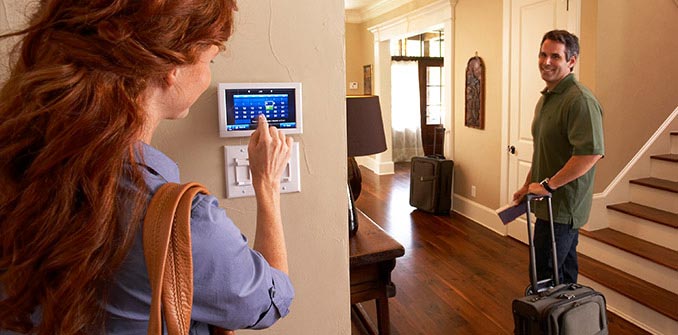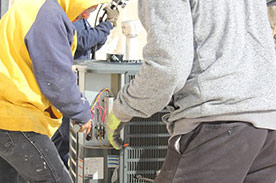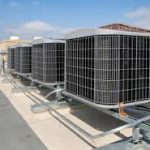If your air conditioner or heat pump system is not working, start at LOST COOLING CAPACITY for help in diagnosing and repairing the trouble.
Let’s introduce the most basic concepts of air conditioning first:
A detailed list and photos of air conditioner components can be seen at AIR CONDITIONER COMPONENT PARTS.
- A air conditioning or heat pump compressor which compresses low pressure refrigerant gas into a high pressure, high temperature gas. Usually the compressor is in the outdoor portion of an air conditioning or heat pump system.
The air conditioner or heat pump compressor unit is basically a high pressure pump driven by an electric motor. The air conditioning compressor is usually packaged in the outdoor compressor/condenser unit illustrated by our page top drawing.
See COMPRESSOR CONDENSER, and see REFRIGERANT GASES & PIPING
- A condenser or condensing unit: typically a condensing coil inside which high temperature high pressure refrigerant gas flows, and over which a fan blows air to cool the refrigerant gas back to a liquid state (thus transferring heat from the refrigerant gas to the air being blown by the fan). The condenser unit is basically a coil of finned tubing and a fan to blow air across the coil. Usually the condenser unit is in the outdoor portion of an air conditioning system, often packaged along with the compressor motor discussed above.
- A metering device which dispenses liquid refrigerant into an evaporator coil. The metering device may be simply a thin section of tubing (a capillary or “cap” tube) or it may be a bit more sophisticated thermostatic expansion valve (TEV) which includes a temperature sensing control that can open and shut the device against refrigerant flow.
See THERMOSTATIC EXPANSION VALVES or see CAPILLARY TUBES.
- An evaporator coil or cooling coil: typically the cooling coil is a section of finned tubing (it looks a lot like a car radiator) into which liquid refrigerant is metered and permitted to evaporate from liquid to gas state inside the coil. This state change of the refrigerant, from liquid to gas, absorbs heat, cooling the evaporator coil surface and thus cooling indoor air blown across the cooling coil. Usually the cooling coil is located inside the air handler.
See AIR HANDLER / BLOWER UNITS and articles like DIRTY COOLING COIL / EVAPORATOR COIL.
Evaporative cooling systems, or swamp coolers are discussed separately at EVAPORATIVE COOLING SYSTEMS.
- An air handler and blower unit which provides a fan to blow building air across or through the evaporator coil. The air handler blower fan unit moves building air across the evaporator coil surface in order to condition building air by cooling it (and thus also by removing moisture from the cooled air).
See AIR HANDLER / BLOWER UNITS and BLOWER FAN OPERATION & TESTING.
- A duct system which distributes conditioned air from the air handler in to the occupied space (supply ducts), and which takes air from the occupied space and returns it to the cooling system air handler.
See DUCT SYSTEM
- Heat Pump Systems use the same components we have described just above, with the addition of a reversing valve that in essence permits the system to run “backwards” in cold weather. So in air conditioning mode the heat pump is moving heat from inside the building to outdoors while in heating mode the heat pump is moving heat from outdoor air (or water in some designs) to the building interior. Because the ability of a heat pump to extract heat from outdoor air diminishes at low outdoor temperatures, heat pump systems in northern climates also include a backup or auxiliary heating system.
Details of how heat pumps work, are inspected, diagnosed, and repaired begin at HEAT PUMPS.
- Air conditioner controls and features, which include a room thermostat, electrical switches, fuses or circuit breakers, condensate handling system, and air filters.
See OPERATING CONTROLS and AIR FILTERS for HVAC SYSTEMS
Or see THERMOSTATS, HEATING / COOLING for the basics of how to turn the air conditioner on & set room temperature.
For photographs of these various air conditioning and heat pump parts, and for an explanation of where these air conditioning components are physically located, see A/C COMPONENTS which discusses and helps you name and recognize various Indoor A/C Components andOutdoor A/C Components






